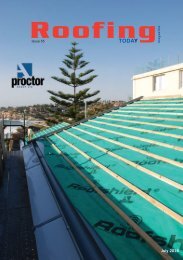Roofing
2kZ2j9o
2kZ2j9o
You also want an ePaper? Increase the reach of your titles
YUMPU automatically turns print PDFs into web optimized ePapers that Google loves.
Health & Safety<br />
Understanding the Dangers of Silica Dust<br />
James Miller, General Manager at Dustcontrol UK, here discusses the main challenges and solutions to this<br />
potentially lethal risk to roofers’ health.<br />
Symptoms usually appear only after prolonged exposure,<br />
however, once they start, the disease invariably progresses.<br />
And it only takes a small amount of silica dust to cause health<br />
problems.<br />
The Health and Safety Executive (HSE), estimates that there<br />
are around 500 silica-related deaths in the UK every year. The<br />
risks posed by silica are not just limited to specific job roles or<br />
niche on-site activities, even simple tasks, such as dry<br />
sweeping and disposing of cement bags, can send silica<br />
particles into the air.<br />
The HSE recommends that businesses take a proactive<br />
approach to minimizing exposure, and controlling and<br />
managing the risk posed by dust. The best way to do this is to<br />
install extraction and filtration equipment.<br />
Most Efffective<br />
On-tool extraction has been proven to be the most effective<br />
method when it comes to stemming the flow of dust migration<br />
and settlement, as extracting at the source limits the chance<br />
of dust particles escaping into the atmosphere.<br />
Extraction units are defined by class. In regards to silica, the<br />
HSE recommends the use of a Medium (M) class or High (H)<br />
class. H class units offer the highest degree of filtration – with<br />
a filter leakage of less than 0.005% – making it the most<br />
effective option in targeting respirable dusts with carcinogenic<br />
properties.<br />
Airborne dusts are the primary cause of respiratory illnesses in a wide range<br />
of industries, including roofing and construction. The World Health<br />
Organisation (WHO) ranks dust-related illnesses as among the UK’s biggest<br />
workplace hazards, and major killers, when it comes to occupational health.<br />
In roofing, one of the most significant and concerning issues is that of silica<br />
dust. Silica is a natural substance found in a variety of raw materials, such as<br />
slate, tiles, granite and brick. The presence of silica itself is not a concern,<br />
however, when these materials are treated (drilled, cut, sanded or blasted)<br />
fine dust particles can become airborne. These microscopic particles, called<br />
Respirable Crystalline Silica (RCS), can make their way deep into workers’<br />
lungs if inhaled, especially likely if work is taking place in enclosed<br />
environments. Different materials contain different amounts of silica, for<br />
example, concrete tiles can comprise between 25-75%, and slate 30%. Even<br />
short periods of roof tile cutting can create high levels of silica dust.<br />
The inhalation of silica dust particles can be particularly hazardous to<br />
long-term health. Silica dust can lead to a condition known as silicosis, in<br />
which scarring occurs in the lungs and breathing becomes difficult. It is also<br />
a well-known carcinogen, and a contributing cause of lung cancer.<br />
The use of H class systems not only offer greater protection<br />
against RCS, but those specifically developed for the<br />
construction industry, such as those with primary separation<br />
by cyclone and cartridge filters, can help prevent tools<br />
clogging up and provide more consistent performance. These<br />
machines are also less likely, due to their higher specification<br />
of containment, to suffer major accidental dust leakage.<br />
There are some roofing businesses that are unsure as to what<br />
they should be doing and what equipment they should be<br />
using, and some may not even be aware they have an issue.<br />
Part of the problem is that roofing work is so varied. Stripping<br />
and re-roofing buildings can involve many different types of<br />
materials, from installing shingles, slate, asphalt and tiles;<br />
repairing asbestos cement roofs; cutting wooden battens; to<br />
insulating roof spaces. It can, therefore, involve exposure to<br />
many different harmful substances which might generate<br />
hazardous dusts. The biggest respiratory health risks for<br />
roofers, after asbestos, are from silica. It is not an option to<br />
ignore these risks, but help is available.<br />
Dustcontrol UK offers free dust assessments, designed to<br />
help educate businesses on the necessary steps they need<br />
to be taking regarding dust extraction. The aim is to<br />
improve working conditions, remove potential health hazards<br />
and encourage ‘healthy business’. Visit<br />
www.dustdoctors.co.uk .<br />
Page 18 <strong>Roofing</strong> Today<br />
Enquiry 8




